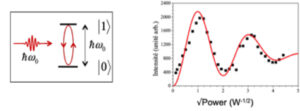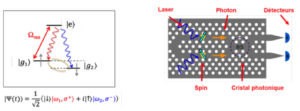Members
Paola Atkinson, Benoît Eble, Richard Hostein (My Cryo Firm Company), François Dubin, Valia Voliotis
Quantum dots based on semiconductor materials can be considered as two level systems and thus constitute “quantum bits” (qubits). Two types of qubits can be implemented, the one with a neutral electron-hole pair or the one with the two spin states of a carrier, electron or hole. To perform logical operations, it is necessary to be able to prepare (initialize) and manipulate (rotate on the Bloch sphere) the qubit very quickly on the scale of its coherence time. This can be done with light pulses by so-called “coherent control” experiments. In the last few years, we have developed resonant spectroscopy experiments of quantum states which have allowed us to demonstrate the Rabi oscillation of the ground state of a neutral pair in a dot. This demonstrates the possibility of initializing the state in any superposition of the two-level system, governed only by the laser parameters (polarization, power). It is then possible to manipulate the prepared state coherently, by coherent control experiments with two pulses whose delay and relative phase are controlled very precisely. All these manipulations are limited by the decoherence processes in the material inducing a loss of coherence of the system and that it is necessary to understand and control [1-2] in order to optimize the fidelity of operations.

Caption:Schematic representation of a two-level system excited at resonance by two short pulses shifted in time by a delay δ, and whose relative phase is φ. The Rabi oscillation between level 0 (empty dot) and level 1 (dot with a photo-created electron-hole pair) is observed as a function of the excitation laser power. The oscillations are damped because of the finite lifetime of the system but also because of the dephasing induced during the excitation.
The future developments are oriented towards the entanglement of two qubits, the spin-photon entanglement and the integration of the emitters in photonic circuits (photonic crystals for efficient and versatile coupling with light, one-dimensional waveguides as transmission channels for photons, realization of interconnected networks). Our main objective for the next few years, thanks to the funding of an ANR project, is to realize a demonstrator for basic quantum information protocols using quantum dots. These elementary bricks, whose charge can be controlled, will be inserted in a deterministic way in photonic crystal structures. This project, combining localized growth by molecular beam epitaxy, design and fabrication of nanophotonic structures, will allow the realization of coherent all-optical spin manipulation in order to demonstrate the entanglement of two distant spins via a photon in an all-integrated device.

Caption: Schematic representation of a system in Λ and the spin-photon interface. The spin state is initialized to the g2 state; the spin qubit is controlled by light pulses and the polarization of the emitted photon is entangled with the corresponding spin projection. On the right is represented the all-integrated device allowing to demonstrate the entanglement between distant spins on the same chip.
- Centre de Nanosciences et Nanotechnologies
- Laboratoire de Photonique Numérique et Nanosciences
- ANR ISQUAD (2019-2023)
- DIM SIRTEQ (QD-SPIN 2019-2021)
- DIM SIRTEQ (QCM 2018-2020)
Publications
[1] Leonard Monniello, Catherine Tonin, Richard Hostein, Aristide Lemaitre, Anthony Martinez, et al.. Excitation-Induced Dephasing in a Resonantly Driven InAs/GaAs Quantum Dot. Physical Review Letters, American Physical Society, 2013, 111 (2), pp.026403. ⟨10.1103/PhysRevLett.111.026403⟩. ⟨hal-01229170⟩
[2] A. Reigue, F. Lux, L. Monniello, M. Bernard, F. Margaillan, A. Lemaître, J.Iles-Smith, J. Mork, R. Hostein, and V. Voliotis, Probing exciton-photon interaction by two-photon interferences in a resonantly driven quantum dot, Phys. Rev. Lett. 118, 233602 (2017) https://doi.org/10.1103/PhysRevLett.118.233602

